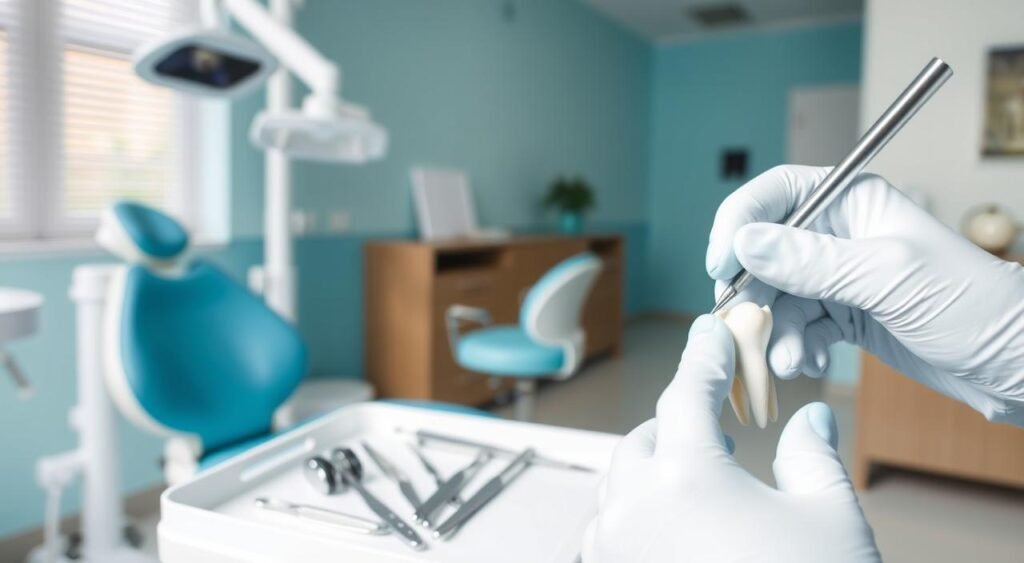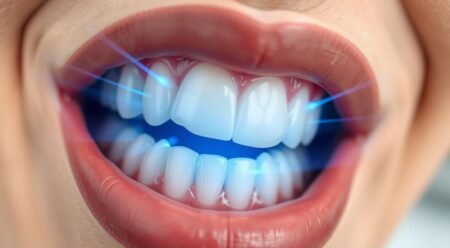Are you one of the 47% of adults over 30 who might need more than just a regular dental cleaning? Deep cleaning teeth procedures, also known as scaling and root planing, could be the key to preserving your oral health. But what exactly does this treatment entail, and why might you need it?
Periodontal deep cleaning goes beyond standard cleanings to tackle stubborn plaque and tartar buildup. It’s a key step in stopping gum disease from getting worse and saving your teeth. If you’ve noticed bleeding gums, persistent bad breath, or loose teeth, you might be a candidate for this specialized procedure.
Understanding the deep cleaning teeth procedure is essential for anyone concerned about their gum health. From the initial consultation to the final follow-up, this treatment can significantly impact your oral and overall well-being. Let’s explore what you need to know about this vital dental intervention.
The Deep Cleaning Teeth Procedure
Deep cleaning teeth is key for those with gum disease. It’s a non-surgical treatment that goes deeper than regular cleanings. It tackles issues below the gum line.
What is a deep dental cleaning?
A deep cleaning involves scaling and root planing. It removes plaque and tartar from below the gum line. This helps fight gum disease and keeps your mouth healthy.
When is a deep cleaning necessary?
You might need a deep cleaning if you see:
These signs often mean you have periodontal disease. This needs more care than regular cleanings offer.
Differences from regular cleanings
Unlike regular cleanings, deep cleanings target areas below the gum line. This treatment is more detailed and might need several visits. Dentists work in sections, treating each part separately.
The cost varies, from $100 to $450 per section. This depends on where you are and how bad your gum disease is.
The Process of Deep Teeth Cleaning
Professional dental deep cleaning is more than just a regular cleaning. It removes plaque and tartar, even in deep pockets around your teeth. This is for those with gum disease.
Preparation and Examination
Your dentist will start with a detailed exam. This includes x-rays and checking gum pockets. If pockets are 5 millimeters or deeper, a deep cleaning is suggested. This usually takes two visits to clean both sides of your mouth.
Scaling: Removing Plaque and Tartar
The first step is scaling. Your dentist uses special tools to clean above and below the gum line. This removes buildup that regular brushing can’t get.
Root Planing: Smoothing Tooth Roots
After scaling, root planing smooths out tooth roots. This stops bacteria from attaching and helps your gums heal.
Final Treatments and Aftercare
Your dentist might apply fluoride or antibiotics to protect your teeth and gums. You might feel sensitivity for up to two weeks after. Keeping up with oral hygiene and regular check-ups are key to your oral health.
- Deep cleaning usually takes 2 or more visits
- Local anesthesia is often used for comfort
- Regular cleanings may be needed more frequently after a deep cleaning

Benefits of Deep Cleaning for Periodontal Health
Deep cleaning helps a lot with gum disease prevention. It gets rid of plaque and tartar below the gum line. This is something regular cleanings can’t do.
By removing harmful bacteria, it reduces gum inflammation. This makes your gums healthier overall.
Deep cleaning stops gum disease from getting worse. It gets rid of bacteria and smooths out tooth roots. This helps gums attach back to teeth, protecting them from damage.
It also helps fight bad breath, a sign of gum disease.
Deep cleaning is key to keeping your smile. It stops tooth loss by fixing periodontal problems at their source. Healthy gums mean a strong tooth and jawbone foundation.
- Reduces gum inflammation
- Stops gum disease progression
- Protects tooth roots
- Fights bad breath
- Prevents tooth loss
Even though deep cleaning has many benefits, some might feel temporary sensitivity or discomfort. Your dentist will help you manage these feelings. They’ll make sure you recover smoothly.
What to Expect During and After the Deep Cleaning Teeth Procedure
A deep cleaning teeth procedure, also known as periodontal deep cleaning, is a thorough process aimed at improving your oral health. Understanding what to expect can help ease any concerns you may have about the treatment.
Pain Management and Anesthesia
Your comfort is a top priority during the deep cleaning teeth procedure. Local anesthesia is typically administered to minimize discomfort. The treatment usually takes about 90 minutes for a half-mouth cleaning, with full mouth treatments often split into two appointments.
Post-procedure Care and Recovery
After your periodontal deep cleaning, you might experience:
- Gum tenderness
- Slight bleeding when brushing
- Tooth sensitivity
These symptoms usually subside within a few days. Your dentist will provide specific care instructions. This may include avoiding certain foods and modifying your oral hygiene routine. Full recovery typically takes 4-6 weeks.
Follow-up Appointments
Your dentist will schedule a follow-up appointment to monitor your healing progress. Regular maintenance cleanings every 3-4 months are often recommended. This helps maintain the benefits of your deep cleaning teeth procedure. With proper care, you’ll see improved gum health and reduced periodontal pockets over time.
Remember, dental insurance often covers 80% of deep cleaning costs. This makes it an accessible option for maintaining your oral health. If you’re experiencing signs of gum disease, don’t hesitate to discuss a periodontal deep cleaning with your dentist.
Conclusion
A deep cleaning teeth procedure is key for good oral health. It’s more than just regular cleanings. It tackles problems that can cause gum disease and other serious issues.
Dentists suggest this every six months. But, it depends on your specific needs.
During a deep cleaning, your dentist will scale and root plane your teeth. Scaling gets rid of plaque and tartar. Root planing makes the tooth roots smooth.
This can help with gum inflammation, bad breath, and even cavities. Local anesthesia is used to make you comfortable.
If you see signs like bleeding gums, bad breath, or loose teeth, it’s time for a deep cleaning. It’s not a one-time thing. You might need more than one session.
By getting regular deep cleanings, you’re not just making your smile better. You’re also protecting your health.
Frequently Asked Questions
What is a deep dental cleaning?
A deep dental cleaning, or scaling and root planing, removes plaque and bacteria from below the gum line. It’s needed when bacteria get below the gumline, often in gum disease.
When is a deep cleaning necessary?
You might need a deep cleaning if regular cleanings don’t work. It’s for those with signs of gum disease. It stops gum disease from getting worse and helps keep your teeth.
How is a deep cleaning different from a regular dental cleaning?
Regular cleanings clean teeth above the gum line. Deep cleanings go below the gum line to remove bacteria and tartar that regular cleanings miss.
How is the deep cleaning teeth procedure performed?
First, an exam and x-rays are done. Then, scaling removes plaque and tartar with tools. Root planing smooths the tooth roots to stop bacteria from sticking. After, you might get fluoride or antibiotics.
What are the benefits of a deep cleaning for periodontal health?
Deep cleaning stops gum disease from getting worse. It helps gums attach to tooth roots again. It also lowers cavity risk, gets rid of bad breath, and protects your teeth and jawbone. It’s key for keeping your mouth healthy and avoiding big problems.
Is a deep cleaning painful?
Yes, local anesthesia is used to make sure you’re comfortable. You might feel some tenderness, bleeding, or sensitivity later. But, you’ll get instructions on how to take care of these feelings.
How long does recovery take after a deep cleaning?
Recovery usually takes 4-6 weeks. You’ll need to follow special oral hygiene and care instructions. You’ll also have a follow-up to check on your healing.








